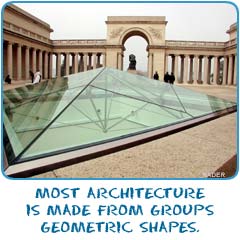Three-Dimensional Shapes
 Now we've gone and done it. 3-D. That term stands for three-dimensional. It means an object that has depth. It's an object that you can hold. You are a three-dimensional object. Your computer is a three-dimensional object. Your balls in the toy chest are three-dimensional objects. Everything in the world is three-dimensional. 3-D objects with corners are called polyhedrons in math. It's a word related to polygon (2-D objects). Let's look at a few basic shapes...
Now we've gone and done it. 3-D. That term stands for three-dimensional. It means an object that has depth. It's an object that you can hold. You are a three-dimensional object. Your computer is a three-dimensional object. Your balls in the toy chest are three-dimensional objects. Everything in the world is three-dimensional. 3-D objects with corners are called polyhedrons in math. It's a word related to polygon (2-D objects). Let's look at a few basic shapes...
Spheres and Spheroids
You know that ball you use on the playground? That ball. That perfectly round ball. Is a sphere. Spheres are smooth surfaces with no edges. How do you make a sphere? Take a circle and spin it around its centerline. It is just that simple. Spheroids are round objects that weren't made with perfect circles. A great example of a spheroid is an egg.Pyramids
You may already know about pyramids. You might have seen pictures of pyramids in Egypt or Central America. Many ancient cultures made monuments in the shape of pyramids. Pyramids are three-dimensional shapes with one flat bottom and sides that are all triangles. The most common pyramids you see will have bottoms with three and four sides.Cylinders and Cones
These are some round shapes with either a bottom or top and bottom in the shape of an ellipse or circle. A cylinder is a shape that has ellipses for its top and bottom faces. The side is a smooth surface with no corners. What is a good cylinder shape? Think about fluorescent light bulbs, pipes, or a thermos for cylinders you see every day. You might not see cones every day, but they are out there. Cones look like triangles that have been spun around a central line. They are very sturdy shape and often happen in nature. Go out to a sandbox and pick up a handful of the sand. If you let it out of your hand in a slow stream, it will probably form a cone shape on the ground (round base and pointy top). If you really need an example, think about an ice cream cone. Those cones aren't called cones for nothing.Prisms
Prisms are a really cool and used in physics to break white light up into different colors. But what is the actual shape of a prism? The basic idea of a prism is that there are two parallel shapes that can have any number of sides. Those sides are connected by rectangular pieces. The prism used in physics has two faces (top and bottom) that are triangles and three connecting sides that are all rectangles.More 3D Shapes
There are so many shapes. Let's just say there are way too many to discuss on this introductory page. We have a few favorites that we want to share. A toroid is a donut shape. It's like a tube that has been bent in a complete circle. A helix is a twisting shape. DNA is made in a special helix shape. A corkscrew or spring is a great example of the shape of a helix. A helix can twist in a right-handed or left-handed direction. Let's finish up with a dodecahedron. We just like the name. It's just a simple twelve sided object made up of faces that are in the shape of pentagons (5-sided polygons). Some dice are in the shape of dodecahedrons.Related Activities

|
Three-Dimensional Shape Name Quiz
- Play Activity |

|
3-D Shapes Memory Challenge
- Play Activity |
Useful Reference Materials
Wikipedia:https://en.wikipedia.org/wiki/Pre-algebra
Encyclopædia Britannica:
http://www.britannica.com/topic/mathematics
College of the Redwoods:
http://mathrev.redwoods.edu/PreAlgText/





